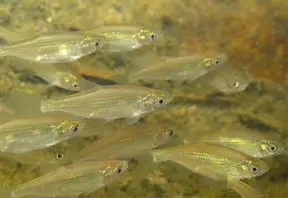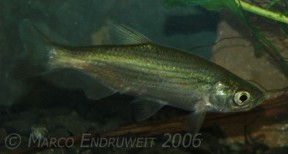Metzia lineata
SynonymsTop ↑
? Clupea huae Tirant, 1883; Ischikauia lineata Pellegrin, 1907; Rasborichthys altior Regan, 1913; Rasborinus hainanensis Nichols & Pope, 1927; ? Clupeoides huëensis Chevey, 1932
Etymology
Metzia: named for Charles William Metz, Stanford University, who helped authors identify fishes collected in Japan.
lineata: from the Latin lineatus, meaning ‘lined’, presumably in reference to the colour pattern comprising a series of thin, dark, lateral stripes on the body.
Classification
Order: Cypriniformes Family: Cyprinidae
Distribution
Currently considered to occur in southern China (Pearl River system in Guangxi, Guizhou, Yunnan, and Guangdong provinces, Jiulong Jiang and Jin Jiang drainages in Fujian province, Red River in Yunnan province), Hainan Island, Hong Kong, and northern Vietnam (Red River basin).
Type locality is ‘Tonkin, Red River drainage, northern Vietnam’.
It has been introduced to a number of river systems in China and is now also present in northern Laos, while records from Taiwan appear to refer to the congener M. mesembrinum.
Habitat
Inhabits slow-moving to still habitats, typically containing clear to turbid water and abundant aquatic or riparian vegetation, including streams and other minor tributaries, rice paddies, marginal ditches, and canals.
Typical sympatric species include the congener Metzia formosae, Barbodes semifasciolatus, Rasbora steineri, and Macropodus opercularis.
Maximum Standard Length
80 – 100 mm.
NotesTop ↑
M. lineata can be distinguished from the similar-looking congener M. mesembrinum by the following combination of characters: 15-17 (vs. 13-14) branched anal-fin rays; 18-20 ( vs. 15-16) predorsal scales; 36-39, mean 37.3 lateral line scales (vs. 35–37, mean 35.8).
Populations from the upper Pearl River (Nanpan Jiang basin) differ in several morphological characters from those inhabiting Guangdong, Guangxi, and Guizhou Provinces, and Hainan Island. Those from Vietnam also seem to be different (Gan et al., 2009), the implication being that there may be several species currently included under the name M. lineata.
Although it is included in the genus Metzia this grouping remains somewhat unresolved in terms of taxonomy and it may contain more than a single genetic lineage. For example, members share a number of characters with the genera Ischikauia Jordan and Snyder 1900, Hemiculterella Warpachowski 1887, and several species of Anabarilius Cockerell 1923, including a bipartite gas bladder, a non-spinous dorsal-fin ray, and a sharp ventral keel between the pelvic-fin insertion and anus.
Metzia was also recovered together with the genus Hemigrammocypris in a phylogenetic study published in 2010, thus rendering it paraphyletic. In addition, M. formosae and M. longinasus differ from most other members of the genus in mouth position (upturned vs. terminal in putative congeners) and number of lateral line scales (43–48 vs. 35-39), and M. bounthobi differs from all congeners in number of branched anal-fin rays (18-20 vs. 10-18) and lateral line scales (49-55 vs. 35-48).
The current concept of Metzia can be diagnosed as follows: body compressed; abdomen with a sharp ventral keel between pelvic-fin insertion and anus; no barbels; no symphysal projection on the lower jaw fitting into a depression on upper jaw; lateral line complete, curved ventrally anterior to pelvic-fin insertion, running parallel with ventral profile and extending through centre of caudal peduncle above anal-fin base; gas bladder bipartite, posterior chamber with a rounded distal extremity; last simple dorsal-fin ray not spinous, origin closer to caudal-fin base than tip of snout or posterior to a vertical through pelvic-fin insertion; 10-20 branched anal-fin rays; 35-55 lateral-line scales.
References
- Pellegrin, J., 1907 - Bulletin du Muséum National d'Histoire Naturelle (Série 1) v. 13 (no. 7): 499-503
Mission permanente Française en Indo-Chine. Poissons du Tonkin. - Gan, X., J.-H. Lan and E. Zhang , 2009 - Ichthyological Research 56(1): 55-61
Metzia longinasus, a new cyprinid species (Teleostei: Cypriniformes) from the Pearl River drainage in Guangxi Province, South China. - Ho, H.-C. and K.-T. Shao, 2011 - Zootaxa 2957: 1-74
Annotated checklist and type catalog of fish genera and species described from Taiwan. - Kottelat, M., 2013 - Raffles Bulletin of Zoology Supplement 27: 1-663
The fishes of the inland waters of southeast Asia: a catalogue and core bibiography of the fishes known to occur in freshwaters, mangroves and estuaries. - Kottelat, M., 2001 - Environment and Social Development Unit, East Asia and Pacific Region. The World Bank: i-iii + 1-123 + 1-18
Freshwater fishes of northern Vietnam. A preliminary check-list of the fishes known or expected to occur in northern Vietnam with comments on systematics and nomenclature. - Kottelat, M., 2001 - WHT Publications, Colombo: 1-198
Fishes of Laos. - Shibukawa, K., P. Phousavanh, K. Phongsa and A. Iwata, 2012 - Zootaxa 3586: 264-271
A new species of Metzia (Cypriniformes: Cyprinidae) from northern Laos. - Tang, K. L., M. K. Agnew, W. J. Chen., M. V. Hirt, T. Sado, L. M. Schneider, J. Freyhof, Z. Sulaiman, E. Swartz, C. Vidthayanon, M. Miya, K. Saitoh, A. M. Simons, R. M. Wood and R. L. Mayden, 2010 - Molecular Phylogenetics and Evolution 57(1): 189-214
Systematics of the subfamily Danioninae (Teleostei: Cypriniformes: Cyprinidae).



